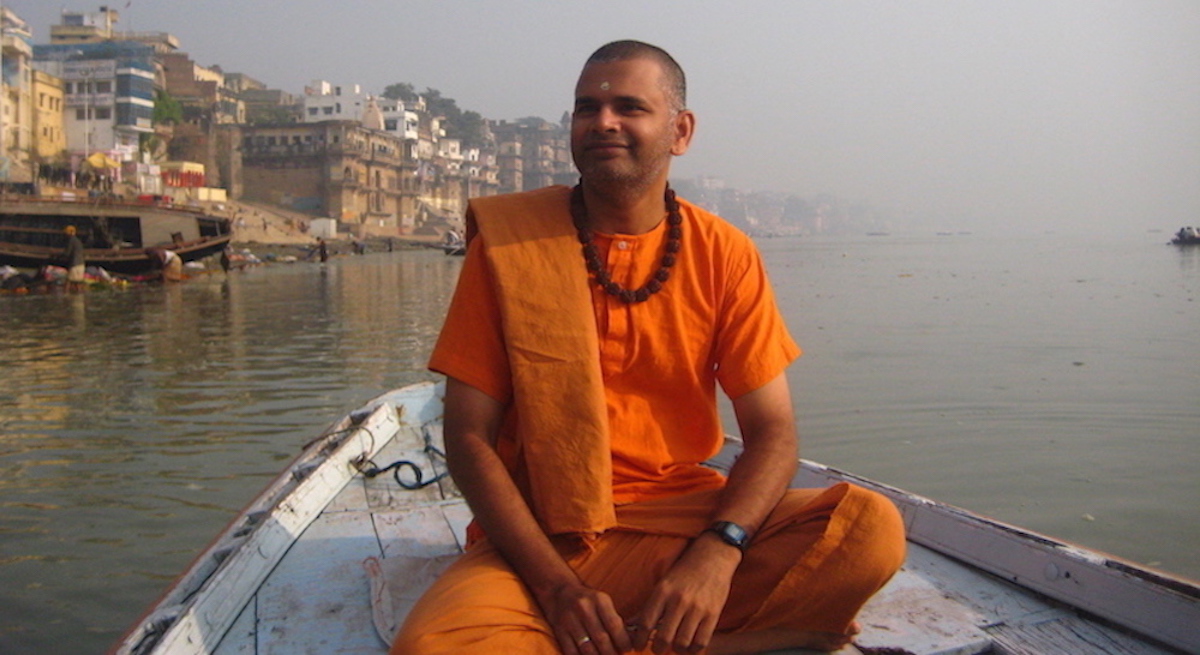Shum.tyam , welcome to Shum Sanctuary. I am the Founder and Webmaster of Shum Sanctuary and my name is Guhanatha Swami. Since my childhood I've had an interest in mysticism. The desire to meditate came naturally to me and when I met my guru in my teens that desire blossomed into a discipleship with him. It was my guru who introduced me to the Shum language during a decade long discipleship in his monastery. This is my mystic journey of how a language helped guide me to uncover spiritual enlightenment.
- Early Years
- My Guru
- Becoming A Monk
- The Shum Room
- The Self-God
- Rehnadee Shum–Shum Sanctuary's Shum
- Shum and You
Early Years
Do you know what ESP (Extra Sensory Perception) is? When I was a kid in the late 70’s ESP mind-powers such as telekinesis–moving stuff around by simply staring at them–and other cool telephatic abilities intrigued me. At the time I knew nothing of meditation or Hindu mysticism, it was all Uri Geller and his spoon-bending exploits and of course the awesomeness of Star Wars' Jedi Knights. It wasn't until I got a hold of Ramayana (a Hindu epic) by Amar Chitra Katha did I get to know of the path of discipleship under Hindu gurus who taught meditation. As I dove deeper into the Hindu myths I learned that an ardent meditator under the tutelage of a guru could commune with God. In the myths God would appear to austere meditators and grant them boons and this captured my imagination and interest deeply.
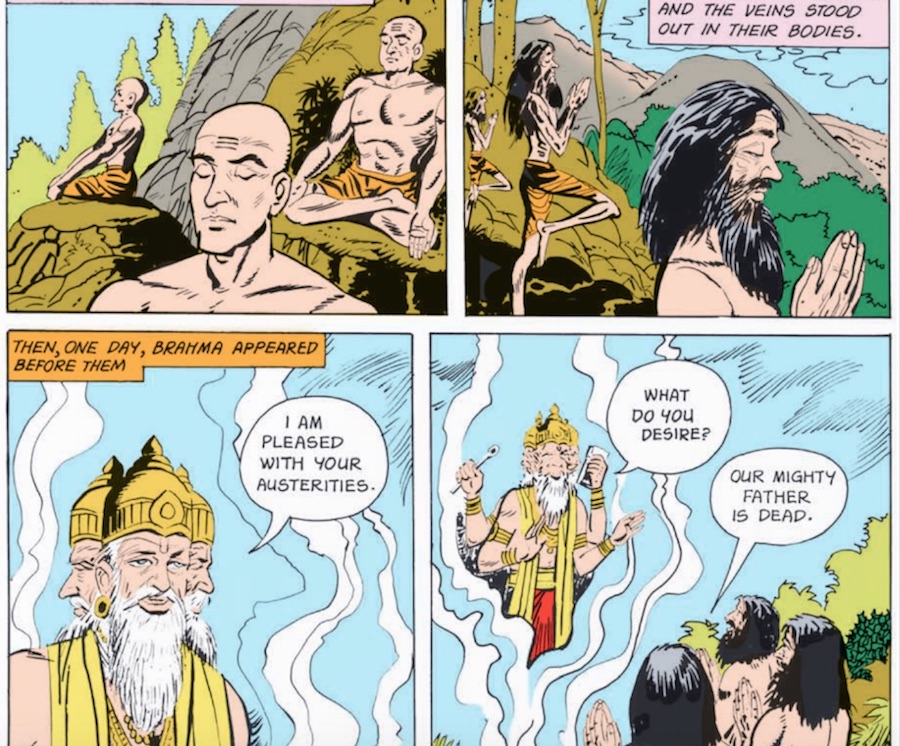 Amar Chitra Katha is a publisher of comic books about Indian myths and history.
Amar Chitra Katha is a publisher of comic books about Indian myths and history.
The Hindu myths showed me the path–find an enlightened guru and learn from him. At the time I was 11 years old and obviously my conviction was tempered by me being, well…a kid. I thought how difficult could it be to meditate. So I set out naively on a DIY meditation path. I learned to sit in the lotus meditation posture by examining closely the pictures in the comics. Then from a different story I learned that Lord Vishnu would appear to his devotees if they incessantly chanted His mantra 'Om Govinda Hari-Hari'. Being prone to sleepless nights one night I sat in lotus posture and started chanting 'Om Govinda Hari-Hari' until I fell asleep hoping something special might happen. Lo and Behold! Something did happen the next morning–I woke up with a terrible bellyache! Later after my father took me to see a doctor to quell the pain I figured that I had swallowed too much air into my belly while enthusiastically chanting the mantra, thus the excrutiating colic. However it wasn't a fruitless endeavour because I learned a valuable lesson– that I need a guru to teach me meditation.
In that vein, a year later in an effort to find a guru and learn meditation I took up a Korean martial art–Tang So Do (similar to Tae Kwan Do). This path was influenced by the 70’s TV series Kung Fu which was about a Shaolin monk–Caine, travelling the US West in the 1800’s. Each show featured Caine’s spiritual training in China with his Kung Fu master who nicknamed Caine ‘Grasshopper.’ I thought I might have a similar relationship with my Tang So Do master as Grasshopper did and gain some mystic powers. I did see my martial arts master meditating on and off, and I was hopeful that as I progressed deeper in the training that he would teach me. However all I ever learned were kicks and punches and I gave up the practice altogether after my master told me that I wasn't getting angry enough when I fought. He wanted me to have the fighting spirit when all I wanted to master was the 'spirit', spirit; and that was that.
You would think that being a Hindu finding a guru would be easy but that was not the case in Malaysia when I was growing up. My parents were not connected to any gurus, nor were gurus part of my religious life as a child. It was not until a seminar on Hinduism held in my school that a clear path to a guru came to pass. The seminar and subsequent classes on Hinduism that followed were enlightening as they gave philosophical perspective to the Hindu culture I was living and showed how the practice of meditation was essential to achieving life's ultimate spiritual goals. In time I would meet the master who provided these teachings–a charismatic American man who was a Hindu guru.
 Gurudeva poses with Lord Nataraja, a deity of Lord Shiva.
Gurudeva poses with Lord Nataraja, a deity of Lord Shiva.
My Guru
Satguru Sivaya Subramuniyaswami or Gurudeva was the founder of Saiva Siddhanta Church, a Hindu Church based in America. His mission in Malaysia was headed by a group of youth he had inspired to teach Hindu philosophy across the country based on his book Hindu Cathecism. I took steps to be a member of the Church so I would have the opportunity to become his disciple and learn meditation. The first ever meeting I had with Gurudeva was when I was 17 as part of a group of students aspiring to become members of his Church. In that first up close meeting I was too shy to ask him questions so I just sat in silence basking in his spiritual presence. After the session and in a less formal setting I got the courage to talk to Gurudeva personally as he was waiting to leave. I told Gurudeva that I was working on controlling my anger and if he had any advise for me. He asked my name and told me to just keep at it, that it will become easier if I persisted. He said that in the beginning I would still lose to anger but at least I would be aware that I lost control. If I didn’t give up on the effort I will certainly win. Then he instructed his swami travelling with him, Muruganathaswami, to give me a book–The Clear White Light and asked for my name again so he would remember me. I was elated after the meeting and when I returned home that night I read The Clear White Light cover to cover. It was the perfect book for me and it surfaced my deepest mystic desires and convinced me that I had found my guru.
The Clear White Light is an essay on nascent mysticism for aspiring meditators that Gurudeva had written when he was beginning his spiritual mission in America. It inspired me deeply and is still a joy to read. You can read The Clear White Light by clicking this link. It is published on Himalayancacademy.com. Following are some of my favourite excerpts.
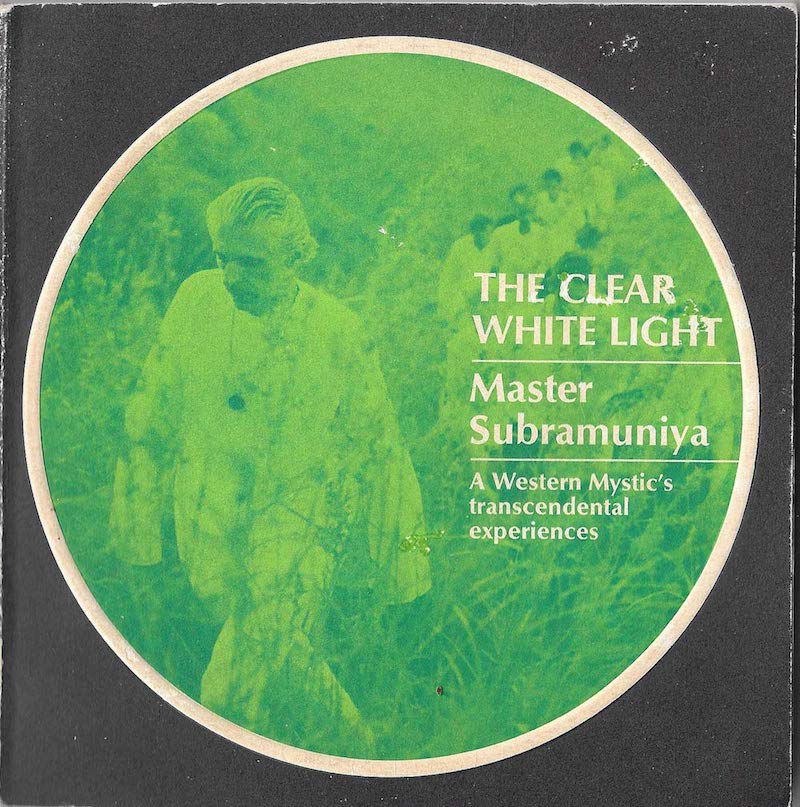 The Clear White Light, a booklet that anchored me to a
The Clear White Light, a booklet that anchored me to a
mystic goal in my early attempts at meditation.
“Whenever darkness comes into the material world, this centered man is light. He sees light within his head and body as clearly as he did in former states of materialistic consciousness when looking at a glowing light bulb. While involved in innersearching some hidden laws of existence or unraveling the solution to a problem of the outer mind, he sits viewing the inner light, and the light shines through the knitted law of existence, clearly showing it in all its ramifications, as well as shining out upon the snarled problem, burning it back into proportionate component parts.”
“Occasionally, in a cross-section of the inner mind, when light merges into transcendental form, the young aspirant may view the golden actinic face of a master peering into his, kindly and all-knowing. He is looking at his own great potential. As the clear white light becomes more of a friend to his external mind than an experience or vision and can be basked in during contemplative periods of the day, the nourishment to the entirety of the nerve system, as ambrosia, bursts forth from the crown chakra. This is identified inadequately as “the peace that passeth understanding,” for he who reaches this state can never seem to explain it.”
“Remember, when the seal is broken and clear white light has flooded the mind, there is no gap between the inner and the outer. Even uncomplimentary states of consciousness can be dissolved through meditation and seeking again the light.”
“The uninitiated might ask: “What is it like to be in the clear white light?” The young aspirant may reply, “It is as simple as sitting in a darkened room, closing the eyes in deep concentration and finding the entire inside of the cranium turning into light.” At first it may be only a dim, moon-like glow, a pale flicker of several different colours, but then it becomes as bright and intense as the radiance of the noonday sun, then crystal clear and white.”
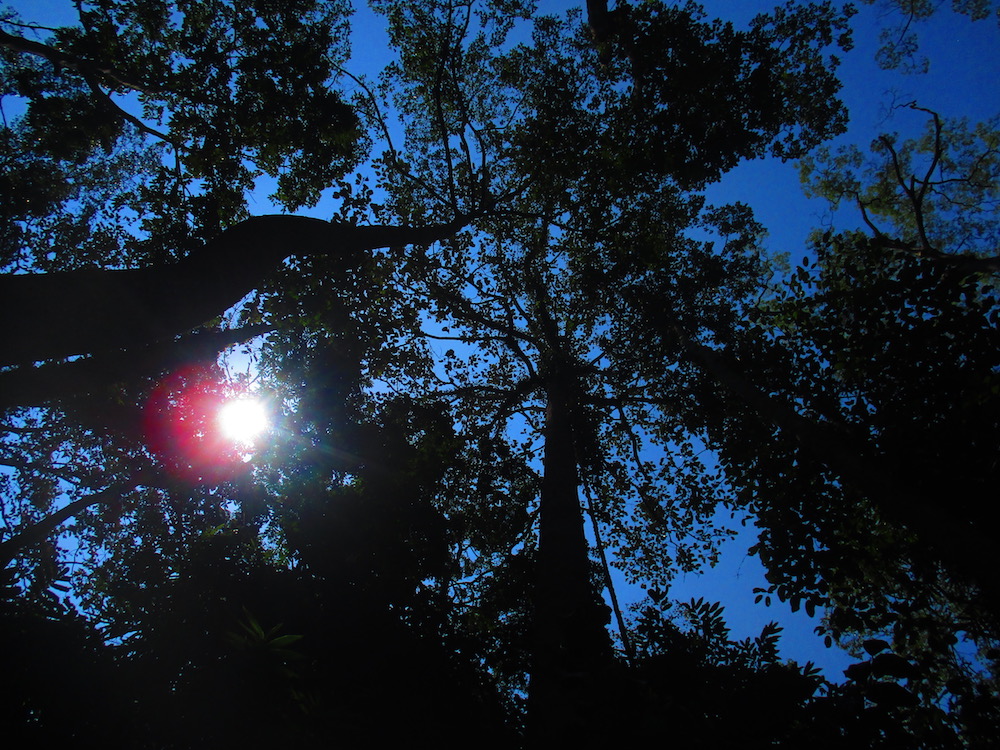 Looking up at the Sun through the shadows of the forest,
Looking up at the Sun through the shadows of the forest,
an abstract of The Clear White Light.
The Clear White Light was my first introduction to Gurudeva as a mystic and it inspired me greatly. It revealed an astute master of meditation and it gave me my first ever goal of meditation–to see the clear white light in my mind.
After reading The Clear White Light and having met Gurudeva in the exuberance of my youth I thought somehow his spiritual power might propel me into the clear white light. All I had to do was to persist in my effort. So I set a schedule for myself to meditate every night before sleep. I believed surely one day soon I will enjoy basking in God’s Light. It seemed so simple, so I created a routine of worship and meditation before sleep that lasted about 40 minutes each night.
In the first weeks just sitting in lotus posture for more than 20 minutes was painful but my body was able to adjust. After that there was a major gap in steps–what was I to do in my mind with my eyes closed. It was dark, pitch black with just the sound of the fan whooshing away so I started chanting Lord Shiva’s mantra, Aum Namasivaya, hoping that at anytime I might dramatically experience a burst of the clear white light. However within seconds of mantra chanting my mind would float away from the quest for The Light to irrelavant thoughts. I tried for months to no avail. It was frustrating, as if I reached a dead-end in my meditations. It had finally dawned on me that meditation was no child’s play–that I needed more than inspiration to meditate successfully. However the effort did produce results for my studies, ease of concentration and better memory helped with my grades in my final year of high school but the prize of real mystical revelation eluded me. Nevertheless I didn't lose hope. I knew that Gurudeva had given me the book for a reason and that it would bear out in the future.
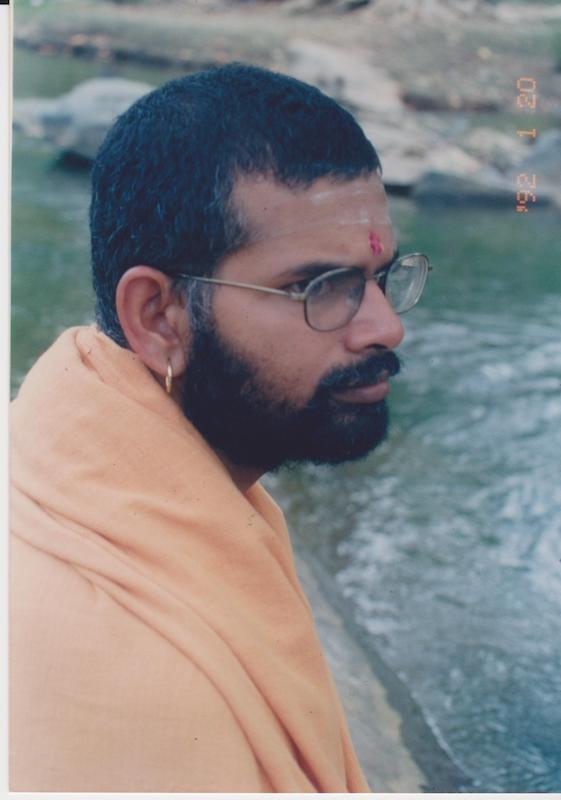 Guhanatha Swami. Founder of ShumSanctuary.com.
Guhanatha Swami. Founder of ShumSanctuary.com.
As of the publishing of this article all my hair has turned white.
Becoming a Monk
My years of formal study organised by Gurudeva's fellowship in Malaysia centered on his rendering of Saiva Siddhanta–a mystical and philosophical school within the broad spectrum of Hinduism. However the Shum language wasn't part of this study. Even when senior monks from Gurudeva's monastery came on missions to Malaysia Shum wasn't taught. All that I knew of Shum at the time (this was in the mid 1980's) was that Gurudeva had created the Shum language for meditation. Nevertheless the philosophical study inculcated in me an even deeper yearning for mystical goals. I learned of The Self-God that lied beyond the Clear White Light. It is the ultimate state of God-Realisation. The mystic who achieves this prized state of enlightenment is recognised among mystic masters as a fully enlightened person.
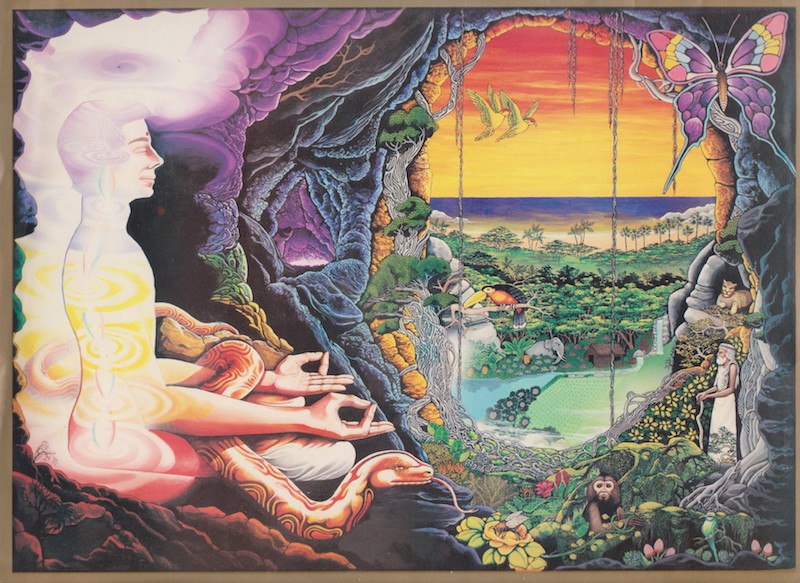 Artistic depiction of Gurudeva Realising The Self.
Artistic depiction of Gurudeva Realising The Self.
This was in the Jalani Caves, Sri Lanka in 1949. Art credit: Himalayan Academy
As I passed my 19th birthday my desire to realise The Self (The Self-God) was a smouldering fantasy. At the time I was all prepped to go to medical school. My father who was a medical doctor had reserved a seat in a medical school for me. However before enrolling I had a few months to spare. Gurudeva lived on the Island of Kauai in Hawaii where he headed a Hindu monastery, Kauai Aadheenam. The monastery had a special training programme for male youth of his organisation called Task Force. Task Force was an opportunity for me to live a monk’s life for two to six months before going to varsity. The training was to further develop our spirituality and values which would guide us through our adulthood. It was for me a once in a lifetime opportunity to learn meditation directly from Gurudeva, so I enthusiatically applied.
On January 12, 1991 I arrived at Kauai Aadheenam to start on the Task Force programme. I was prepared for an austere 2 months. That was how I imagined a monk’s life would be. As soon as I arrived at the monastery I was taken to meet Gurudeva in his office–The Mahogany Room. It was a cosy office beautifully designed, posh and plush with Gurudeva greeting me with open arms. My first impressions of the monastery was not of austerity, rather it was kindness and openness. Here was Gurudeva in his home. Up until then I only saw Gurudeva in formal functions which were stooped in traditional Hindu protocol. But here I was in a cosy and easy going atmosphere enjoying homemade mint icecream, chocolate chip cookies and tea with Gurudeva and few of his young monks. I wondered if I was going to experience austerity or have fun! Nevertheless I felt deeply that the time I was going to have with Gurudeva would be nothing but transformational for me. It so happened that I kept extending my 2 months stint to the full duration of 6 months. The max period that my visa had allowed.
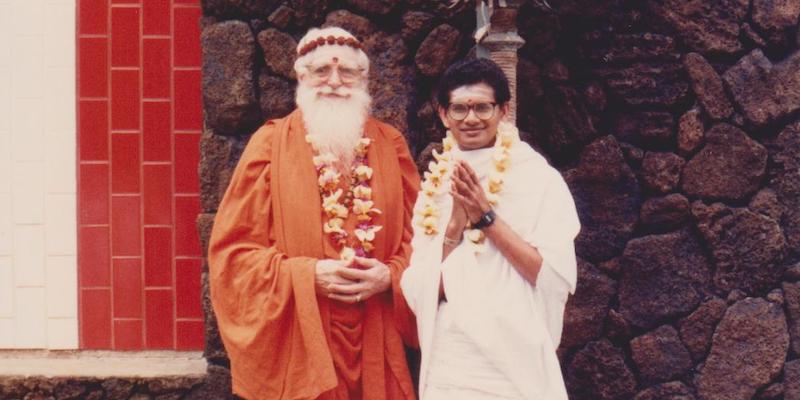 Gurudeva and I. When I first arrived in Kauai Aadheenam, 1991.
Gurudeva and I. When I first arrived in Kauai Aadheenam, 1991.
I learnt my first Shum words during the Task Force. In the monastery instead of saying thank you, we said MooLingShum–it is Shum for thanks and the response to a thanks is TyayKaVum. These were my first two words of Shum. I also learnt my first Shum meditation. We woke up pre-dawn and attended a temple service before sitting with Gurudeva for a 45 minute group Shum meditation. The group meditation had a leader, a senior swami who would call out Shum words which were commands. It went like this:
 LeShumNamBe: Sit in lotus posture or any posture with the
LeShumNamBe: Sit in lotus posture or any posture with the
spine erect and head relaxed and balanced on the spine.
 KaLeBaSa: Concentrate on your breath, inhale and exhale the same counts in and out
KaLeBaSa: Concentrate on your breath, inhale and exhale the same counts in and out
using odd numbers 5, 7 or 9.
 LeOoNaSe: Feel the vital energy, prana, that generates the warmth of the body.
LeOoNaSe: Feel the vital energy, prana, that generates the warmth of the body.
 SimShumBeSee: Feel the power of the spine and perceive the flow of energy within it.
SimShumBeSee: Feel the power of the spine and perceive the flow of energy within it.
 NeKaShum: Feel LeOoNaSe and SimShumBeSee simultaneously and command LeOoNaSe
NeKaShum: Feel LeOoNaSe and SimShumBeSee simultaneously and command LeOoNaSe
to absorb into SimShumBeSee and move up into the cranial chamber.
 Kaef: Be aware of awareness aware of only itself.
Kaef: Be aware of awareness aware of only itself.
 EeKaef: Concentrate on the high pitched ‘eee’ sound that can be heard within the cranial chamber.
EeKaef: Concentrate on the high pitched ‘eee’ sound that can be heard within the cranial chamber.
 Emkaef: The dissolution of awareness. The Self, the ultimate goal of Shum meditation.
Emkaef: The dissolution of awareness. The Self, the ultimate goal of Shum meditation.
To conclude the meditation Gurudeva would say NeKaShum and we would begin to gradually come out of meditation by following the steps in reverse–SimShumBeSee, LeOoNaSe, KaLeBaSa and LeShumNamBe and finally the meditation leader would say ShumNam RehTyamBa–to end the meditation.
This meditation was different than what I had been exposed to thus far. I had read books such as Auto Biography of a Yogi, Swami Sivananda'a books, even Lopsang Rampa. Never had I sat or tried a meditation that was so dynamic–meaning, each step or command of this Shum meditation lasted about three to five minutes and involved tasks which were various breathe modulation, visualisation or concentration techniques. Nothing in the Shum instructions was ambiguous or had a wait-and-see-what-happens-after instruction. I was sitting in one place without moving–the simplest definition of meditation–but in my mind I was constantly occupied, as if I was finishing one chore and moving on to the next. This was a far cry from the way I was meditating before–that always careened into this large gap of unfettered time during and after chanting mantras–which got filled with the struggle to maintain concentration against ceaseless waves of thoughts. In contrast this Shum meditation proved its effectiveness within a couple of months when I had a mystical breakthrough. It was a vision of the chakras along my spinal cord and cranium that became an awe inspiring and transformative moment for my spiritual life. Firstly it provided me experiential evidence of the reality of the chakra system and more importantly brought to life the philosophy Gurudeva taught–that the purpose of life is to Realise the Self. Realising the Self became a goal I felt I could achieve with Gurudeva's help. My ambition of becoming a medical doctor which was motivated by a desire to serve humanity began to unravel. It dawned on me that if I was Self-Realised I could help others on this path. I also realised that such a pursuit in life was rare, somehow one less doctor in the world wouldn’t mean as much as one less mystic. It is this train of thought that lead me to want to become one of Gurudeva’s monastics, to serve and train directly under him. So I returned home to Malaysia after finishing the Task Force programme with a mission to get the blessings of my parents to make my spiritual pursuit the primary goal of my life. As it happened a year later I was back in Kauai Aadheenam, this time with the horizons of my future clear–I wanted to achieve the prize of meditation–to realise The Self-God.

The Shum Room
The Shum language was mystically revealed to Gurudeva in 1968 while he was with a group of young followers in a travel-study program he called Innersearch in Ascona, Switzerland. At the time Gurudeva was looking to find a solution to teach meditation more effectively. The Story of Shum–How Gurudeva discovered Shum is a fascinating story and instead of retelling it here in Shum Sanctuary I will direct you to this link in Himalayan Academy to download the free book, Twelve Shum Meditations. On page 4 is The Story of Shum–a story that underscores the rare quality of a human being with unbridled passion for mysticism who was Gurudeva, a guru that I was fortunate to have had the privilege of serve and learn from, whose passion for the mystical rubbed-off on me through the decade of the 90's that I was in the monastery.
The first few years in the monastery–this time training to be full fledged monastic in the Saiva Siddhanta Yoga Order–was focused on developing personal skill and emotional maturity, it was actually quite mundane. Gurudeva sussed out our disinclinations and put it right in front of us as a challenge, and for me that was managing the monastery’s kitchen, including cooking for 30 people a day. It was totally out of character for me and in the beginning a formidable challenge. Later I would come to realise that breaking barriers within the mind especially self-made and self-imposed ones was key to spiritual growth. Humility, perseverance, flexibility in mind and emotional maturity, including qualified faith are foundations for developing mysticism.
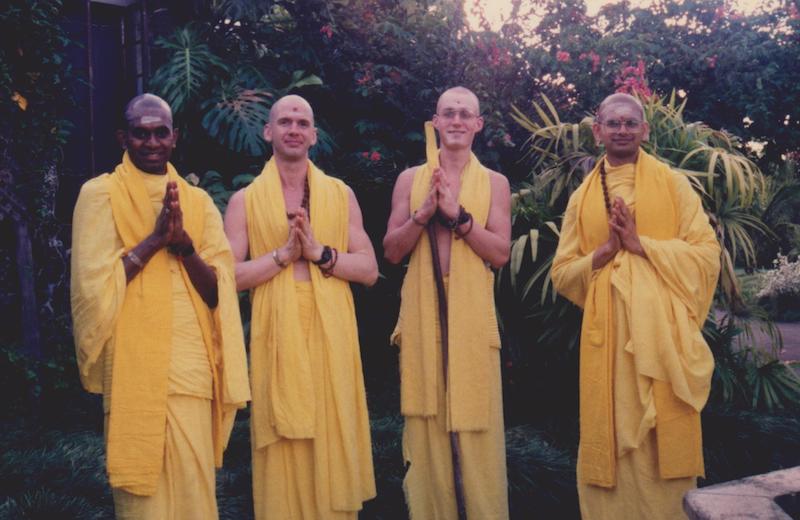 Becoming a Yogi Tapasvin (1995). A important stage in my progress as a monk. I am right-most.
Becoming a Yogi Tapasvin (1995). A important stage in my progress as a monk. I am right-most.
At this point I had already been in the monstery a few years but I hadn’t learned much more Shum than what I had learned from when I was in Task Force. I enjoyed Shum meditation but its specialness wasn’t yet clear to me. I reasoned that if the same Shum words had been couched in English it would still be effective; LeShumNamBe, could be ‘Step One’ KaLeBaSa–Step Two and so on. The language was secondary to the actual instruction that we learned in English anyway. However this perception changed when Gurudeva created the Shum Room in 1996 and gave the monks full access to it.
The Shum Room was a place in the monastery where Gurudeva worked on creating new Shum words and organising them Shum into the Shum Lexicon. The Shum room has an extensive library of all the Shum words that Gurudeva had discovered since its inception in the late sixties–an unparalleled geography of the mystical world. As I learned word after word of Shum I realised how necessary the language was to capture the breadth and depth of the mystical universe. It also became clear how effective Shum was for efficiently laying out and organising descriptions and techniques to explore and master the vast Innerverse of the mystic mind. Trying to replace Shum with a known language would be cumbersome and futile. One Shum word of seven syllables will easily expand into at least a page of descriptions and instructions. I was a frequent visitor to the Shum Room which became my otherworldly portal where I would chart mystical journeys into the Innerverse. It was a place of adventures for me where I would spend many hours in the room absorbing the details of many words and later speaking to Gurudeva about them. Gurudeva enjoyed elucidating and discussing Shum words and he recognised my deep interest in Shum and enjoined me to start my own Shum diary to record my discoveries and chart my progress. He also gave me Shum assignments and shared with me insights of how to teach Shum.
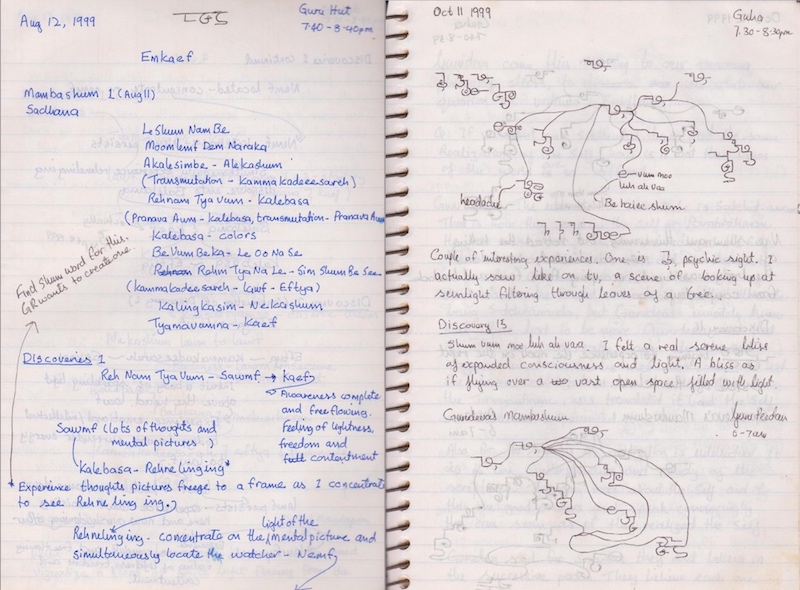 My personal Shum diary, it was always an uplifting experience to draw out a meditation map after meditating. On recall I will often stumble on mystical experiences that were new discoveries. The Shum diary is an essential tool for progress in Shum meditations, not only does it chart one's progress on The Path of Enlightenment, it also helps to determine successive meditation maps that will eventually bring the Shum meditator to the ultimate goal of The Self.
My personal Shum diary, it was always an uplifting experience to draw out a meditation map after meditating. On recall I will often stumble on mystical experiences that were new discoveries. The Shum diary is an essential tool for progress in Shum meditations, not only does it chart one's progress on The Path of Enlightenment, it also helps to determine successive meditation maps that will eventually bring the Shum meditator to the ultimate goal of The Self.
My first ever Shum Diary entry was on August 12, 1999. At the time I couldn’t write in Shum script yet so I would write out Shum romanised. It would take me another month to pickup Shum calligraphy and start writing in Shum. Maintaining my Shum diary was very inspiring for me. I always looked forward to that time everyday when I would draw my meditation map in my Shum diary. More often than not I would stumble on a new mystical experience that I had not realised that I had had in meditation until I recalled the meditation for the Shum Diary. It was always inexplicable whenever this occured and this taught me of the wisdom of Gurudeva in urging me to start my Shum Diary. If not for the Shum Diary so much valuable insights and leads to mystic progress would have been missed and go unappreciated. I learned from this how essential a tool the Shum Diary is for progress in meditation. Whenever I had the chance I would meet with Gurudeva to understand experiences that I had uncovered with the help of my Shum Diary. Otherwise I would scour the Shum Lexicon in the Shum Room to find the word for the experience and discuss it later with Gurudeva. Thus my Shum vocabulary increased as my mystic depth deepened with practice.
Gurdeval left the study of Shum in the monastery to individual initiative. There was no in-depth or structured study of the language made available even for the monks. Instead Gurudeva created the Shum Room and made himself available from 5 to 5.30am, which was just before the daily temple service and group meditation, for Shum discussions. Gurudeva was happiest discussing Shum with us and encouraged us to thumb through Shum Lexicon during our free time and make a list of words that caught our interest to discuss with him in the morning. It was through maintaining my Shum diary and nuanced discussions of Shum words with Gurudeva that I discovered that I had realised The Self, Emkaeef; during one of our group meditations in 1996.
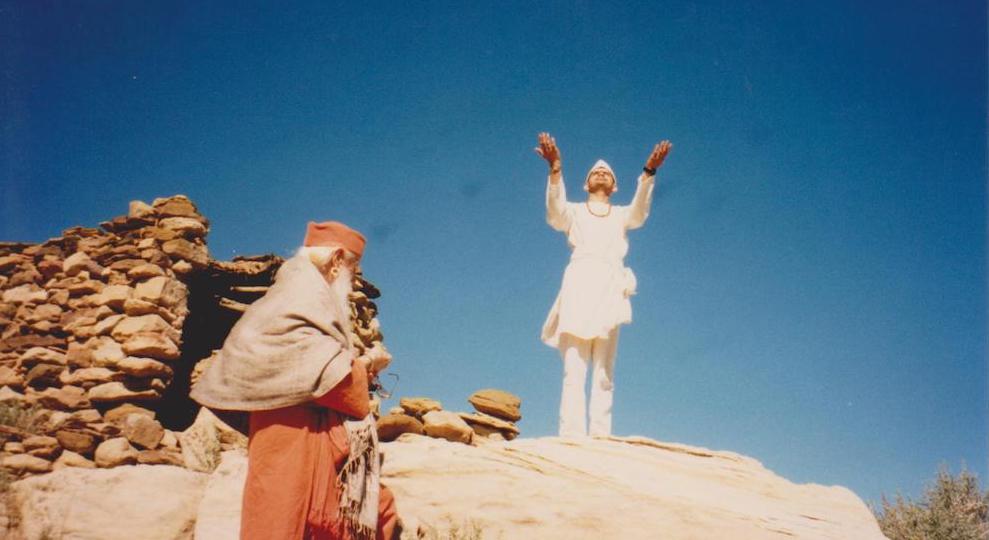 Gurudeva and I during our travels to the mystical Hopi Indian lands in the state of Arizona, US.
Gurudeva and I during our travels to the mystical Hopi Indian lands in the state of Arizona, US.
Like the Shum Diary another key advancement that the Shum language brings to the practice of meditation is its metered approach to meditation. Shum meditations can be tailored to the initial and growing ability of a mystic. As I learned from Gurudeva meditation is just like every other art. Not only does practice make perfect but the nuaunce necessary to determine the best starting point for a meditator and then his or her gradual build up towards the ultimate goal of The Self-God can be planned and executed. With Shum language individual paths that reach The Self-God can be carved. This is the reality of the path toward enlightenment, its not the same for everyone. Using the Shum language we can not only map out these different paths to The Self-God, we can also discover new ones as the language develops among mystics who use it. I trully enjoyed the step by step spiritual growth that Shum meditations offered. I went through so many exhilarating mystical breakthroughs on the way to the Self-God. Shum meditations gave me the confidence that I needed to achieve lofty spiritual enlightenment experiences by advancing from one Shum meditation map to the next I finally reached the peak that I had been yearning for–The Self-God.
The most exciting and wondrous part of my time with Gurudeva and life in the monastery had to do with the Shum language. In discussing my experiences and discoveries with Gurudeva an entire universe, the Innerverse, was revealed to me. Every time I close my eyes to meditate it is adventurous because of Shum even to this day. There is always some mystical experience to strive for or that I might uncover from a smorgasbord of words. The Shum language really is about enjoying mysticism. If you are a mystic or even an aspiring mystic being driven by a mysterious yearning to open up The-World-Of-The -Shut-Eye, you too will feel the draw of the Shum language as I had to explorte the world of subtle joys and wonders that is the panacea for pilgrims of the spiritual.
Shum was my world while I was in the monastery and I had hoped that I spent the rest of my life in the monastery exploring the Innververse with Gurudeva. However that was not to be. Gurudeva's health got the better of him and he passed away on November 13, 2001, he was 74.
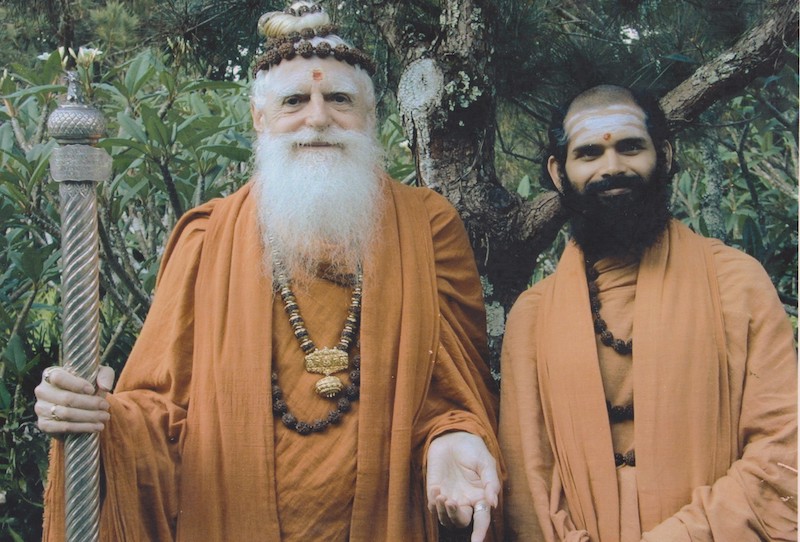 Gurudeva and I after my initiation as a Swami in 1999
Gurudeva and I after my initiation as a Swami in 1999
The Self-God
Gurudeva knew that I had attained The Self-God before I realised it myself. He would simply ask me out of the blue occasionally, "have you realised The Self?" In all my humbleness I thought it would take decades of meditation for me to attain The Self-God and I would simply respond with an unequivocal, "No". The Self-God can be defined as the experience of 'non-experience.' This definition itself is cloaked in mystery–how could one possibly fathom no-experience (other than perhaps death)? The answer lies in its aftermath. Just like we can contemplate the un-created Universe by beholding the Universe itself, we actually have to convince ourself that we have had the ultimate state of spiritual enlightenment by realising a key change in our spiritual pursuit–we start to lose the desire to realise the Self-God. It was the practice of writing my Shum Diary that finally brought me the humbling realisation that I had attained The Self. The first time I realised The Self was in 1996 during the predawn group meditation session. At the time I had been living in the monastery for about four years. All the preconceived idea that I had built up from reading Hindu myths of the austere requirements necessary to have God appear to a meditator deluded me from accepting the fact that I had already met the qualification to touch into the ultimate state of divinity.
"The Self doesn't make you great, it just makes you complete," Gurudeva told us, his monastics, in one of his last sermons to us. When I heard those words it just rang so true to me because I can feel the completeness. Gurudeva had also given me a personl advise related to The Self-God. He told me this before I accepted that I had already realised The Self. After giving him his breakfast he commented on how brilliant my eyes looked and asked me again if I had realised The Self. This time I answered him with a maybe. He laughed a bit and told me, “After Self-Realisation you must help at least one other person realise The Self.” Little did I realise then that these words would turn to become a mission for me. This quest led me to leave my cherished monastery shortly after Gurudeva had passed. Then 10 years later in the hallowed halls of the mystical Shiva temple in Chidambaram, India I fulfilled this mission when I lead my first disciple to The Self-God as my guru did for me using the Shum language.
Rehnadee Shum–Shum Sanctuary's Shum
I am in my 50's now and my love of Shum has only deepened. To me the Shum language was the most precious gift that Gurudeva left humanity and I feel especially humbled to have been initiated into the language directly by its purveyor. Shum Sanctuary is an outgrowth of the mission that my guru had instructed me, that is, to help others Realise The Self.

In the years that have passed since I had left the monastery my spirituality continued to mature as I explored and expanded the Innerverse within myself. With this came the need to create new Shum words and meditation maps. This process led me to innovations to the original Shum that Gurudeva had conceived of in 1969. These innovations mainly involve how new Shum words are created and make the language even more efficient in organising the Innerverse. In 2020 I was divinely inspired to encapsulate all the innovations I had come up with into a new dialect of Shum and named it Rehnadee Shum. Rehnadee Shum is like a software upgrade to v.2. The Shum language is meditation technology and it brings to meditation what languages bring to communication or machine languages bring to computing, thus it too can evolve. Rehnadee Shum is Shum Sanctuary's Shum and it is my service toward the spiritual development of humanity. I believe that Rehnadee Shum's effectiveness as a an universal method for meditation will speak for itself as more people learn to use it to explore the mystical frontiers within themselves and as we tread into the Space Age Rehnadee Shum will bring people together and help mark the dawn of the Spiritual Age.
Rehnadee Shum–A Dialect of Shum. Learn more about the similarities and differences of the two streams of Shum language from this link.
Rehnadee Shum and You
Gurudeva was a Hindu guru and I too am born Hindu and learned Shum within the confines of a Hindu monastery so it is natural to ask if you need to be Hindu to learn Shum. The answer is no and neither do you need to be a monk. Shum is an universal language and the vocabulary of Shum is a holistic geography of our spirit which is common to all of us. A Shum meditator advances in his or her spirituality by attaining mystic experiences and these experiences can cause one's personal beliefs to evolve as the meditator uncovers spiritual truths. Rehnadee Shum is an universal language that anyone can learn and adapt to their life. As a language it will never be a religion however it can neither replace religion. It is just like how yoga which is part of Hindu tradition has now been adapted universally as a type of exercise for health. Shum language provides a similar universal path for meditation born out of Eastern Mysticism.

In this vein there is no word for God in Shum. Instead there is the Path of Enlightenment that aggregates spiritual development to levels that start from a beginner to a Master. Each level has goals of enlightenment which are experiences of ever deepening mystical communion with the Divine as the Path of Englightenment unfolds from one step to the next. The Path of Enlightenment is unique to Rehnadee Shum meditators. There are starting points on the path where meditators need to first build essential Mystic Skills, then as the path progresses to building Mystic Strength from enlightenment experiences the route diverges into many directions that will ultimately reach The Self-God. As a Rehnadee Shum meditator you will carve your own path to The Self-God and you will chronicle that path in your Shum Diary as you move from one meditation map to another. This is the mystic adventure that Rehnadee Shum offers you.
You, whoever you maybe, from where ever you may be are more than welcome to try Rehnadee Shum meditations. This language is really a cataloguing system for that part of our mind that is often left to lofty allegory and poetry simply because we have never had a language to capture its breadth and depth. Now we do. You just have to start meditating in Shum to experience how it can enrich your life with heart-filling mystical experiences. Adapting the practice of Shum meditation to your life is not complicated because there only three facets that needs to be incorporated in your life. The first is a preparation for meditation that is done just prior to meditation, the second is the meditation using a meditation map and the third is maintaining your Shum Diary. You can learn more about this in Rehnadee Shum's Culture of Meditation.
To start with Rehnadee Shum meditations read the articles in Rehnadee Shum's Academy. The Academy is placed at 'Level 0' or the education level before practice, on The Path of Enlightenment. The meditation maps at this level are a study of the foundations of Shum meditation such as The Shum Perspective, How To Read Meditation Maps, The Path of Enlightenment and more. The Academy also has the Basics of Rehnadee Shum which contains the Rehnadee Shum Images List, Language Structure and Syntax and more. The Academy will give you an overview of how Rehnadee Shum meditations work and what makes them so specialised for exploring the Innerverse. As you are going through the Academy you can at any time just pickout anyone of the meditaion maps in the Beginner Level (Level 1) and try the meditation. Meditations at this level are open to all; whether this is the first time you are trying meditation or if you are already a meditator, these meditations will help you familiarise the with Rehnadee Shum meditations by going through the preparation for meditation, meditating using a meditation map and making an entry into your Shum Diary.
Nowadays there are many reasons for meditation. When I was growing meditation was exclusive to spiritual purposes. However medical research in the 80's snf 90's made conclusive connections between the heath of the body and mind. Today the practice of Eastern schools of meditation have become popular for its health benefits–from helping with concentration to stress relief, even healing. Rehnadee Shum meditations at the Beginner and Intermediate Levels provide for these, and if that is all you need from meditation, Rehnadee Shum meditations can also fill this need. Again Rehnadee Shum is a language, it is not a religion, so there is no need for affiliation or membership to practice Shum meditation, though disicpleship is necessary at higher levels of practice.
The Shum language was created out of the need to help mystics fathom the deepest reaches of the Innerverse and if you yearn for such adventures Shum Sanctuary will open the doors to this frontier for you. From the time you start meditating in Rehnadee Shum you will be collecting meditation maps in your Shum diary. As your collection of meditation maps grows over time you will appreciate how the Innververse will have expanded to a vocabulary of experiences and insights that will help you uncover the spiritual purpose of your existence. Eventually this can lead you to become a Shum Master and your Shum Diary will have chronicled your journey on The Path of Enlightenment. If like you more and more people use Rehnadee Shum to meditate, Shum Sanctuary will act as a repository for the diverse paths toward The Self-God. Future generations will come to appreciate this collection of maps as an universal mystic bible that is a chronicle of spiritual journeys.



